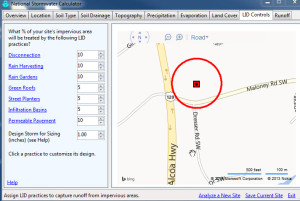By Lee Gentry, PE
Back when I was engaged in nonpoint source stormwater pollution research, the famous opening line of Bulwer-Lytton’s 19th century novel, “Paul Clifford,” invoked an image different than what the author intended. I imagined that it was raining and nobody was looking. But since then, all of that has changed. It’s still raining, but somebody is looking.
Approximately 90 communities in Tennessee are regulated under the Municipal Separate Storm Sewer System (MS4) NPDES Permit Program. The program, which is part of the National Pollutant Discharge Elimination System, is administered by the Tennessee Department of Environment and Conservation.
The program requires that certain qualifying communities obtain a permit to discharge stormwater into streams and other “waters of the state.” Before the nationwide program was launched by the Environmental Protection Agency in the late 1990s, stormwater discharges were generally considered “nonpoint” sources of pollution and were largely unregulated. That all changed with the program.
In Tennessee, the first phase of the program brought the larger communities, including Knoxville, Nashville, Memphis and Chattanooga, into compliance under individual permits. The second phase brought approximately 80 smaller communities into the program under a statewide permit. Recently, more communities were brought aboard. In all cases, each community was required to develop and implement a Stormwater Management Program in accordance with the requirements of its applicable permit.
The permits are periodically revised and reissued by TDEC based on guidance from the EPA and previous permit specifications. In 2010, the general permit for small MS4s was revised. The major new requirement was that the first one inch of rainfall on a newly developed or redeveloped project site must be retained (not just detained) on the site. That is, the first inch must be either infiltrated or captured and reused; it cannot be permitted to leave the site (except under very limited conditions). A similar requirement is incorporated into the individual permits for the larger MS4s. The infiltration requirement is intended to address two goals:
- Obtain treatment by retaining the runoff on site
- Reduce the hydrologic effects of development or redevelopment on natural runoff
But this is old news, right? Yes, but most MS4s are now entering the implementation stage of the one-inch infiltration requirement. It is interesting that one little inch of rainfall has been as confounding as it has! As it turns out, the accepted methods of computing runoff volume don’t seem to work well for addressing the new requirement.
The classic so-called small storm “Simple Method,” based on a runoff-coefficient derived solely from the percent imperviousness of the site and other surface conditions, does not work well since it inevitably results in a net volume of runoff regardless of rainfall depth and land use. Likewise, the familiar “Curve Number Method” is not applicable to these small storms. The more complex methods (such as Green-Ampt) built into our favorite computer tools (like SWMM and HEC-HMS) don’t appear to be sensitive enough to the subtleties of small storms and soil complexes to be as reliable as we would like. Consequently, a number of new methods are being proposed.
One interesting tool is the “Stormwater Calculator” recently released by the EPA. Despite its ease of use, the program is relatively robust for small sites with near-uniform soil conditions. The software permits the user to select a specific geographic location, and input its soil type, land use distribution, topography and infiltration characteristics. The user also selects a long-term rainfall record and an evaporation pattern from the available data.
Finally, the user can select from a number of Low Impact Design (green infrastructure) practices to treat and retain runoff. By tweaking the LID practices, the user can determine the combination that will manage one inch of rainfall as characterized in the period of record analyzed. Drawbacks include:
- The soil conditions must be relatively uniform
- The infiltration analysis is simplified
- The analysis does not directly address the specific requirements of the permit but must be determined indirectly
A very promising method is being developed by the University of Tennessee SMART Center in collaboration with TDEC. This method, called “RRAT,” is tailored for application in Tennessee, which incorporates:
- An extensive database of soil characteristics and LID practices
- A soil moisture accounting approach for multilayered infiltration using agriculture hydrology principles
- Geographically based rainfall properties derived specifically for the application
We recently participated in a testing workshop for the program and found the tool to be robust, flexible and intuitive. The final program remains under development and testing, but we understand it should be made available through TDEC later this year.
In addition to these two methods, there are a number of other approaches being developed to address the one-inch infiltration requirement.
And, as you have probably already surmised, we at LDA are also looking independently at some ways to incorporate the small storm infiltration requirement methods into our site infrastructure design models.
For those of us who like dark and stormy nights, these are exciting times to be in the stormwater business! Call or email us if you’d like to talk about these or other stormwater issues.

